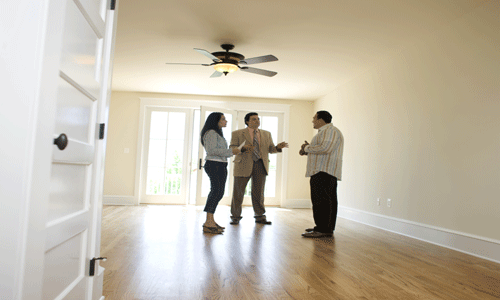Bottom Line: Carpet area in proportion to the super built-up area or saleable area is something that has been a bone of contention between the builder and the homebuyer.
 In the entire short history of real estate in India in general, and Mumbai in particular due to space constraints, apprehensions of builders providing lesser carpet area has been on top of the mind of homebuyers when they decide to buy a flat. In terms of the consumer complaints this is way higher than any other reason why a homebuyer locks horns with the builder in the court of law.
In the entire short history of real estate in India in general, and Mumbai in particular due to space constraints, apprehensions of builders providing lesser carpet area has been on top of the mind of homebuyers when they decide to buy a flat. In terms of the consumer complaints this is way higher than any other reason why a homebuyer locks horns with the builder in the court of law.
After all, carpet area is the space that a homeowner is going to use. In a market where the homebuyer education is not much in public discourse, the understanding about carpet area, covered area including internal walls, built up area and super built up area is pretty confusing, if not outright poor.
All that most of the homebuyers understand is the carpet area that one is going to use and call it their home. And hence, there is always acrimony with the builder about what percentage of carpet area vis-à-vis the saleable super area, irrespective of the percentage of loading.
Now, speaking from the real estate standpoint there cannot be standard definition of the percentage of loading in the name of super built up area. This is because super built up area is subject to many variables, including the FSI norms, amenities on offer and others. Most of the analysts therefore are struggling worldwide to suggest an industry-accepted method of property calculation.
As Manju Yagnik, Vice Chairperson of Nahar Group says that there cannot be standardisation on loading unless all the structures are planned in the same way and of the same design. She also makes it clear that loading depends on numerous factors and features of a building, may it be residential or commercial. As long as these features vary, loading will also differ. Percentage of loading depends on the type and size of the project and differs from project to project. A lot depends on the plans of the building and the extent of amenities provided in it. Loading also depends on typical circulation core and the wall areas in an apartment.
“Lack of clarity on loading percentage does play a role in creating a bad reputation to the sector. The customer has the right to understand the loading factor from the developers and developer will explain the same. Customer should buy only if they are convinced. The real estate sector has undergone sea change over a period of time in terms of modernisation and amenities and space provided by the developers. Also, the consumer today is better informed and well aware on the aspects of development and what he wants. He can evaluate better now than ever before the value for the money while buying a home,” says Yagnik.
What is the way out to bring the builder and the buyer on the same level of understanding? Well, developers in Mumbai striving to come out of slowdown have taken the challenge upfront as far as consumer complaints and perception management is concerned.
As a result, they are now selling on the carpet area. A homebuyer can actually measure his carpet area that the developer is promising. This may not reduce the loading share per se but at least puts to rest other apprehensions like what actually the buyer will get in terms of usable space.
Shailesh Puranik, Managing Director, Puranik Builders accepts that it is a new trend that has emerged where the developers are selling as per the carpet area in Mumbai. He nevertheless adds that it is to follow the guidelines of the government which has advised real estate developers to sell as per the carpet area.
“The loading factor is not completely absolved by this. Developers are taking into consideration the total cost before finalising per sq ft pricing of the apartment prior to initiating sales under carpet area. Defining carpet area and selling real estate as per the carpet area makes a great difference to the customer as well as the real estate developer. Selling carpet by all or a majority of developers has strengthened the trust and confidence levels between the real estate developer and his customers,” says Puranik.
Dhaval Ajmera, Director, Ajmera Realty says the developers are selling only on carpet areas today due to the rules and regulations. For carpet area, it is completely transparent because the charges are only for the carpet area received by the customer. Hence, the trust and transparency is at the forefront.
“The trend of selling is now being accepted by the buyer also because they understand that the charges are applied on the area being used. Yes, the selling rates go higher in terms of carpet area but ultimately the ticket size remains the same,” says Ajmera.
Adhering to the carpet area also enhances transparency in real estate deals. Selling as per the carpet does not make any difference in the ticket size of the apartment. But it does a world of good for the homebuyers’ understanding and hence they are quite happy with this emerging trend.
Mohan Tharwani, Managing Director, Tharwani Infrastructure also admits that selling on carpet does not in any way absolve the loading factor. But he adds that defining carpet area and ticket size makes much of a difference as far as trust factor on the developer is concerned.
“Yes, it is always good to declare the carpet area at the very first go, so that the client (buyer) is aware about the value against the actual size of the flat,” says Tharwani.
The selling on carpet area may not make any difference on the loading over and above the usable area, it nevertheless would be seen as one of the emerging best practices. There are many reasons to believe that selling on carpet helps the sector in its quest for image makeover.
It kills the possibility of mismatch between expectations and delivery; buyer knows before hand the amount that one is paying and the actual size that one is getting; it reduces the chances of litigations; and the practice overall helps in the perception management of the sector.
The Mumbai-based developers would like to admit that ever since they have adopted the practice of selling on the carpet area, it has activated the sales channel and at the same time reduced the number of dissatisfied customers in a significant manner.
It might give the impression that the practice of selling on carpet area would be more welcome in the affordable housing but that is just an outside view in Mumbai property market today. As a matter of fact, the practice has been well received across the housing segment, whether it is affordable or mid segment or even luxury housing projects. Analysts therefore are evaluating it as a case study in best practices adopted by Mumbai real estate.





